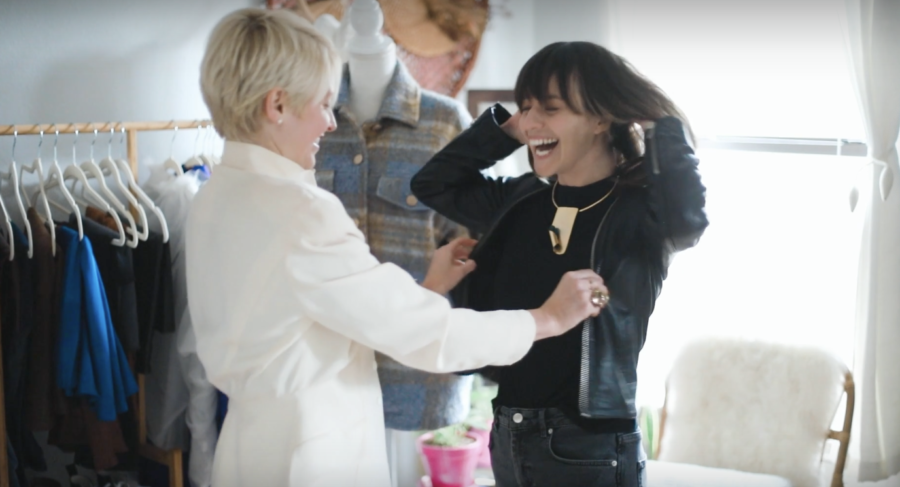I dreamed up this humble little weblog in 2013 after a different-than-expected jaunt in New York vogue PR and a misaligned stint in monetary advertising–neither of which utilized my journalism diploma or made me really feel like I used to be contributing to my neighborhood or the local weather disaster in substantive methods.
However once you enterprise on the improper path, the best one turns into infinitely extra clear. (I think about somebody, someplace mentioned. If not, I stake my declare.)
The backstory goes like this…
The finance workplace I drove an hour to daily, was dominated by frat lord New Balances and boring enterprise caszh. In my first week, I wore what I believed have been respectably tailor-made shorts and bought pulled apart for an HR discuss (didn’t they know I used to be forward of my time?!). By month two, I dropped my hemlines to my knees however adopted louder colours and sample mixing to make up for the blow to my fashion identification. Three months in, my coworkers took to calling me “The Peacock,” a reputation that, on the time, I took too critically as an insult.
I’d go house wishing I nonetheless labored in vogue, however with out contributing to its poisonous influence and tradition. That led down 2 a.m. click on holes exploring sustainable vogue earlier than massive manufacturers like H&M and Lululemon drained it of that means. Due to over- and misuse, “sustainable vogue” is as misunderstood as Severus Snape in the present day.
What I realized led me to start out writing. And once I determined to make issues official and self-publish, I spotted my coworkers weren’t insulting me—they have been spoon-feeding me my model.
The origins of the Peahen title
“Peacocking,” within the wild world of mating, means carrying daring, flashy, or unconventional apparel to draw consideration. It’s a designation largely assigned to males. So at face worth, a peacock didn’t appear proper for me. However I discovered inspiration within the gender function reversal of the species, or peafowl. The male peacock is adorned with colourful feathers for courting. The feminine peahen has subdued feathers and picks her mate from the lot. So I suppose you could possibly say, she wears the feathers—they by no means put on her.
A peahen was a mascot I might grasp my hat on, so I remixed my workplace nickname and the remaining, properly, you possibly can see it on this weblog.
In a decade, I’ve related with and realized from as many individuals as I might on this small area and printed deep dives and opinions about sustainable vogue in hopes of sharing what I’ve realized. Admittedly, these weren’t at all times common, however I hope you’ve discovered them helpful over time.
A part of this journey additionally meant altering my wardrobe by adopting sluggish vogue practices and different consumption channels. However the half I discovered most rewarding occurred outdoors the weblog. I joined organizations that fostered dialogue and neighborhood outdoors of the weblog, printed my writing on retailers with extra attain, labored with folks immediately by promoting secondhand, and, most not too long ago, launched a private styling enterprise.
I’ve been quiet for a while as a result of I’m engaged on an overhaul of The Peahen to merge my writing with my private styling enterprise. I’m calling it Peahen Studio and it will likely be a spot to study sustainable vogue and make it a actuality in your wardrobe. However earlier than the brand new website launches, I figured it was time for some revelry and a retrospective. So right here goes the listicle-ish factor you got here for.
6 issues I’ve realized about sustainable vogue
1. Companies and governments ought to carry the torch.
Since I began running a blog, I’ve seen the rise of the eco-influencer, the confluence of extra moral buyers, and what felt like a bubble bursting with mass retailers peddling acutely aware collections. Ultimately, it turned clear a lot of that is smoke and mirrors. Our moral purchases, nonetheless well-intended, could sadly be serving a delusion.
I’m not saying we shouldn’t all make extra knowledgeable and acutely aware selections about our wardrobes, simply that these particular person efforts can backfire if the system isn’t accountable. Additionally they barely scratch the floor of what companies or governments can do at scale.
With greater than 75 million folks employed in vogue globally, working largely unregulated labor contracts, and Individuals carrying 5 occasions extra garments than they did within the 80s—vogue is, and ought to be, extra politically charged.
As we speak, we want extra deal with advocacy, extra correct sustainability information, and laws to reign in company greed and greenwashing. Organizations like Vogue Revolution and Remake are campaigning for this. And the FABRIC Act stands to implement laws in California that might attain throughout the globe. You’ll be able to take motion by coupling your wardrobe transformation with advocacy. It may be so simple as volunteering at a thrift store (they need assistance sorting stock!), talking up concerning the points to family and friends, and campaigning and voting for legislators who help these payments like Sen. Gillibrand, Sen. Booker, Sen. Warren, and Sen. Sanders. Begin by signing the FABRIC Act petition right here.
2. You’ll be able to’t store your strategy to a greater world.
This follows the above, however probably the most sustainable choice is at all times going to be what’s already in your closet. Consumption patterns are so excessive in the present day that we’ve began to over-consume secondhand garments as thrift shops are inundated with unhealthy haul purchases and Shein trash. The concepts of “charity vogue” and “t-shirts for a trigger” have fueled the neoliberal notion that we will store our means out of inequity whereas throwaway tradition proliferates unabated.
If there’s a trigger you care about, attempt giving time or cash as an alternative of shopping for one thing. When your loved ones finds out you’re into eco-fashion and needs to get you a present, inform them you’d relatively have one thing secondhand or a donation made in your title as an alternative. If you happen to want new garments, actually hone your fashion first. Then, time allowing, attempt different retail channels like resale, rental, and swapping (psst, I can thrift for you and mail you a field). You may also set up a holding interval to think about any new purchases, giving your self time to make sure it’s aligned along with your fashion and current garments.

3. Dogmatism hinders progress.
The moral neighborhood is unquestionably one for sub-group infighting. The staunch vegans could argue towards the pitfalls of plasticized leathers and packaged proteins. The woo-woo varieties who decry all chemical compounds could not acknowledge the development of a material like Tencel over its extra poisonous predecessor, modal. The life-style martyrs could not notice when their conduct turns from inspiring to preachy or nauseating. I misplaced many battles like this early on and know higher more often than not now.
When ingroup combating occurs, it turns extra folks away from the slow-living motion within the title of good consumerism. We will combat this by making extra space for our humanness, acknowledging the humorous impossibility of creating moral selections in our interdependent, capitalistic world, and rallying towards the extra highly effective forces that make it tougher on us—not one another.
4. You (in all probability) shouldn’t begin a vogue model.
Two years into running a blog, I used to be getting so many emails about primary manufacturers launching on Kickstarter I needed to archive them with a Gmail rule. It’s exhausting sufficient to outline private fashion and discover the manufacturers that mirror it, however doing it sustainably offered an entire new set of challenges, particularly when few manufacturers truly seemed good.
At first, they have been granola, then they have been largely beige and primary. It was clear that model homeowners have been both letting their design views get watered down as a result of they didn’t need to compromise their ethics (cloth, sourcing, and manufacturing choices are extra restricted) or getting within the sport with no design perspective within the first place.
Beginning a vogue model is a severe enterprise. To not point out, our vogue system is already over-saturated with designers. So until you could have the singular imaginative and prescient of an artist (or severe capital funding) and an urge for food for nuance — I encourage you to discover different areas of the style provide chain. We’d like extra gifted our bodies in sourcing, policy-setting, and reporting to create change. Bliss Foster explains this extra eloquently than I do.
5. Gifting away issues free of charge hurts all the neighborhood.
I say this within the sense of my very own enterprise practices. I used to be an early adopter of sustainable vogue and my website grew slowly in comparison with conventional vogue influencers. I wasn’t doing LIKEtoKNOW.it (LTK) or collaborating with main manufacturers, however once I was doing partnerships, I wasn’t asking for pay as a result of I believed that my numbers didn’t command it (and lots of early manufacturers bolstered this concept). However I used to be spending hours on skilled content material and connecting eco-brands to a captive viewers they typically couldn’t get with macro influencers.
Giving my time away free of charge not solely hindered my progress, it bolstered the concept different acutely aware influencers would settle for partnerships with out pay. I took this suggestions from my friends critically. As we speak, I’m accepting fewer partnerships than ever earlier than from manufacturers I put on and imagine in. And I’m accepting none with out compensation.

6. I’ll preserve pushing this concept of a Wardrobe Working Zone.
Whereas we’re inundated with local weather doom, we even have extra entry to sustainable vogue than ever earlier than. (Beni anybody?) Navigating this bizarre dichotomy means figuring out what to filter out (lookin’ at you, microtrends) and what modes of consumption be just right for you. The best way a nutritionist may enable you to calculate your macro ratio, I assist my styling purchasers nail down their Wardrobe Working Zone. It’s the best ratio of resale, swapped, rented, and new clothes for you.
Mine hovers someplace round 70% resale, 5% swapped, 10% rented, and 15% new. Over time, the concept is that your Wardrobe Working Zone will begin to skew extra towards different retail and resale channels, shifting you towards slower vogue. With time, and deeper refinement of your fashion, you’ll want fewer “new” gadgets.
If you happen to skimmed this and wish the 2 actionable takeaways…spend extra time on advocacy than buying sustainably and begin your transformation with what’s already hanging in your closet. If you happen to need assistance with that, let’s chat (it’s free).
Been a reader for some time or simply dropped by? Feedback are my favourite breakfast companion. Please, I’d love to listen to from you.
With gratitude for these adolescence,
Kasi

